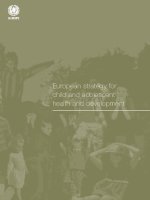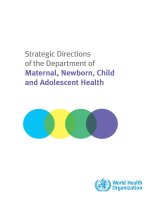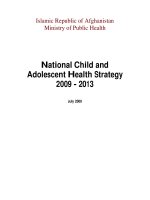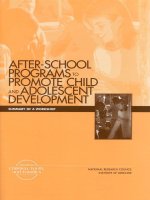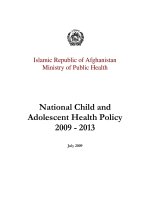child and adolescent counseling chapter 20
Bạn đang xem bản rút gọn của tài liệu. Xem và tải ngay bản đầy đủ của tài liệu tại đây (176.96 KB, 31 trang )
Chapter 20
Counseling with Children
with Disabilities
The miracle is not that we do this work, but
that we are happy to do it.
Mother Teresa
© 2011 Brooks/Cole, A
Chapter Objectives
After reading this chapter, you should be able to:
•Outline the history of special education in the United States
•Explain the categories of disabilities
•Discuss the procedures for IDEA and Section 504 in the
schools
•Describe some counseling strategies for children with
special needs
•Talk about working with the families of children with
disabilities
© 2011 Brooks/Cole, A
Overview
• Children with Special Needs
• History
• Categories
• Methods of counseling by category
© 2011 Brooks/Cole, A
The Situation
• They are different from the norm
• Their problem is just as much society’s perception
as the limitation of the child
• Counseling is only partially about the special need
• It is more about dealing with society’s reaction to
it and the effects of those reactions on the child
• They are often treated poorly both at school and
at home
© 2011 Brooks/Cole, A
Categories of
Exceptionalities
© 2011 Brooks/Cole, A
Steps for identification
1. Child is referred as needing
services.
2. The child is evaluated.
3. A group considers the results and
determines eligibility.
4. If eligible, an individual educational
plan (IEP) is written for the child.
5. The IEP meeting is scheduled
© 2011 Brooks/Cole, A
Steps for Identification (Cont.)
6. The meeting is held and the IEP plan
finalized.
7. Services are provided.
8. Progress measured and reported.
9. IEP reviewed annually.
10. The child is re-evaluated at least every
3 years.
© 2011 Brooks/Cole, A
Methods of Counseling
• Strategies should be incorporated into a positive,
accepting counseling relationship
• Need to have basic knowledge of the disabling
condition as well as the needs and characteristics
of the children
• Listen to them
• Help children see themselves as people who can
and do perform and accomplish goals
© 2011 Brooks/Cole, A
Some General Questions
Have I helped:
• The child develop good relations with classmates
• The child learn to solve his own problems
• The child to feel better about himself
• Parents and teachers interact in ways that help
the child
• The child with his self concept
• The child understand, through my behavior, that
he is a valuable human being
© 2011 Brooks/Cole, A
Emotional Disturbance
• "...a condition exhibiting one or more of the following
characteristics over a long period of time and to a marked
degree that adversely affects a child's educational
performance-(A) An inability to learn that cannot be explained by intellectual,
sensory, or health factors.
(B) An inability to build or maintain satisfactory interpersonal
relationships with peers and teachers.
(C) Inappropriate types of behavior or feelings under normal
circumstances.
(D) A general pervasive mood of unhappiness or depression.
(E) A tendency to develop physical symptoms or fears
associated with personal or school problems." [Code of Federal
Regulations, Title 34, Section 300.7(c)(4)(i)]
© 2011 Brooks/Cole, A
Emotional Disturbances
Children may exhibit
Hyperactivity
Aggression/self injury
Withdrawal
Immaturity
Learning difficulties
Distorted thinking, bizarre behavior
• May include
• Anorexia and bulimia
• Mood disorders
• Trauma
• Chaotic home life
•
•
•
•
•
•
© 2011 Brooks/Cole, A
Emotional Disturbance
Counseling
• Need love and understanding
• Security and stability
• Relationship is very important (history of unstable
relationships)
• Must place consistent limits and hold child
accountable
• Counseling strategies mirror educational strategies
• Be very explicit about appropriate vs. inappropriate
behavior
© 2011 Brooks/Cole, A
Emotional Disturbances
Summary of tasks
•
•
•
•
•
Relationship that includes well defined
responsibilities and limits
Work to change the child’s image and expectations
Individual and group counseling for feelings and
behaviors, teach social skills, improve academic
performance.
Must place consistent limits and hold child
accountable
Assist parents and teachers in how to structure the
child’s environment for consistency
© 2011 Brooks/Cole, A
Learning Disability
• A group of disorders that make
learning more difficult than normal
• Causes: genetic, environmental,
biological
© 2011 Brooks/Cole, A
Learning Disability
Basic definition: achievement is less than
measured potential
•
•
Consequence of definition is that children who
are cognitively limited can’t have a learning
disability
Umbrella terms that cover the following:
dyslexia, dyscalculia, dysgraphia, dyspraxia,
central and auditory processing disorders,
nonverbal learning disorders, visual
perceptual/visual motor deficit, language
disorders
© 2011 Brooks/Cole, A
Learning Disability
Counseling
• Recognize and reflect the child’s
feelings
• The disability itself often causes social
problems
• Requires training in social skills and
self image
© 2011 Brooks/Cole, A
Learning Disability
Counseling
Brief solution focused therapy
•
•
•
•
•
Step 1: Build rapport, define specific problems
Step2: Consider what hasn’t worked – look at
possible solutions
Step 3: Help student decide on specific
measurable goal – “miracle question”
Step 4: Help decide on specific task
Step 5: Check back later
© 2011 Brooks/Cole, A
Learning Disability
Education
•
•
•
•
•
•
•
Changes to classroom procedures
Teach child organizational skills
Teach about considering consequences
Teach social skills
Help child overcome sense of failure
Promote positive attitude toward learning
Complete diagnostic evaluation and
education plan
© 2011 Brooks/Cole, A
ADHD/ADD
• Three types
o
o
o
Predominately inattentive type
Predominately hyperactive/impulsive type
Combined type
• Symptoms
o
o
o
o
o
Present before age 7
Persists for more than 6 months
Present in multiple settings
Inconsistent with child’s developmental level
Clearly impairs functioning
© 2011 Brooks/Cole, A
ADHD/ADD
Treatment
•
•
•
Multidisciplinary, multi-treatment model
Medication alone not recommended but common
Suggestions for counselors
o Behavior modification
o Cognitive restructuring
o Case management
o Parent support groups
o CHADD ()
© 2011 Brooks/Cole, A
Mental Retardation
Definition:
• Mental retardation is a disability
characterized by significant limitations
both in intellectual functioning and in
adaptive behavior as expressed in
conceptual, social, and practical
adaptive skills. This disability originates
before age 18.
© 2011 Brooks/Cole, A
Mental Retardation
Note: each case is so unique it is difficult to
provide general information
• Subtypes:
Intermittent: needs occasional help
o Limited: Need consistent and sometimes intensive
support
o Extensive: Needs regular involvement and long
term support
o Pervasive: constant high intensity support services
o
© 2011 Brooks/Cole, A
Mental Retardation (Cont.)
After diagnosis study four areas
1.
Intellectual and adaptive skills
2.
Psychological and emotional concerns
3.
Physical functioning and health
4.
Current environment and optimal
environment
© 2011 Brooks/Cole, A
Mental Retardation (Cont.)
Counseling goals
•
Provide survival skills
•
Train parents and educators on how to
train the child
•
Case management: ensure the child is
getting the services to which they are
entitled
© 2011 Brooks/Cole, A
Physical Disability
• Disabilities vary widely in extent:
o Diabetes, Cystic Fibrosis,
Pregnancy
• Often comorbid problems
• The child has much negative
association with self
© 2011 Brooks/Cole, A

